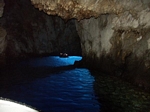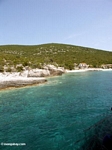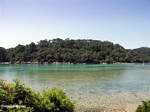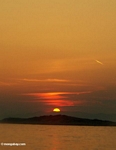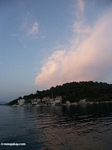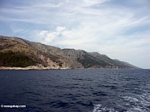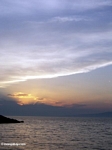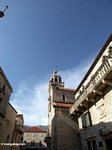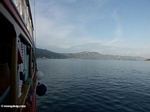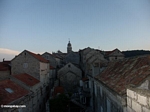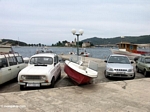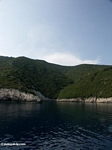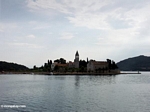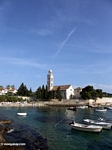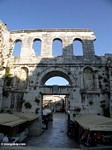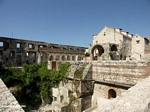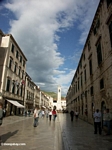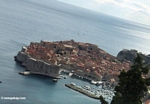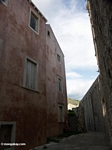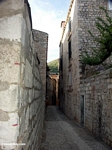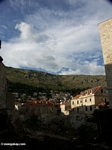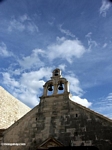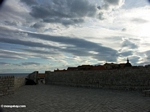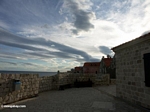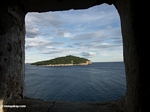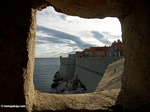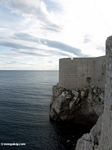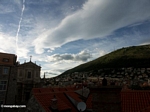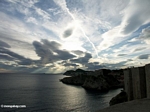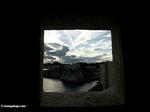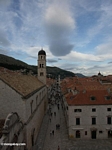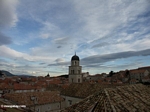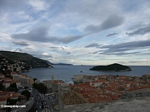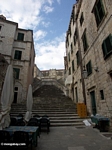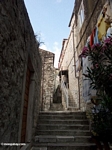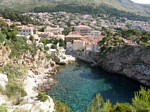Visiting Croatia, tourists replace soldiers
Rhett Butler, mongabay.com
September 8, 2005

Dubrovnik, just north of the historic Grad
Fourteen years ago Croatia was a war zone. Serbian forces occupied about one third of the country and shelled the historic city Dubrovnik. Ethnic cleansing and atrocities were committed and thousands of people were displaced. Today, peace has returned to Croatia and the country is experiencing a tourism boom. With some of the best weather in the Mediterranean and the sparkling waters of the Adriatic there are good reasons that Croatia has regained its former glory at a top tourist destination.
The Republic of Croatia is situated between central, southern and eastern Europe and borders Slovenia, Hungary, Serbian part of Serbia and Montenegro, Bosnia and Herzegovina, Montenegrin part of Serbia and Montenegro. Italy lays just a puddle jump across the Adriatic. Its terrain is diverse, ranging from the lake and hill country of the north and northeast to the densely wooded mountains of the Dinaric Alps to the rocky coastline on the Adriatic Sea. It is this coastal area of Dalmatia that is of the most interest to the average traveler.
Croatia’s coastal areas are especially stunning with crystal clear waters, quiet coves, secluded beaches, dramatic landscapes, and rocky islands. Outside peak tourist season (which is July-September) there is a good chance that many of these places will be completely free of people. If you want to miss the crowds, late June could be a great time to visit. Before then, the weather can be a bit questionable and you might experience rain.
 Clear waters of Adriatic cove, Vis island |
The best way to see the Dalmatian coast or Dalmatia, as this stretch of the Croatian coast is known, is by boat. There are numerous operators who offer boats for rent or you can join a cruise. Regardless of the arrangement, a boat will provide you flexibility in your travels and give you access to remote islands and secret bays. Because of the way sea currents and winds flow, the sea water of the Adriatic is much cleaner and much warmer on the Croatian side than it is on the Italian side making swimming and other water activities particularly pleasant. During the summer the weather is generally quite sunny and the climate is warm.
In addition to its natural attractions and charm, Croatia has a rich history. There is ample evidence of its past in the many ancient villages and ruins scattered across the country’s coastal areas and islands.

HISTORICAL OVERVIEW OF DALMATIA Dalmatia was part of the Illyrian kingdom between the 4th century BC until the Illyrian Wars in the 220s BC when they it was conquered by the Roman Republic. After the Western Roman Empire collapsed in 476, the region was ruled by the Goths up to 535, when Justinian I added it to the Byzantine Empire. In the 10th century the northern half of Dalmatia became an independent kingdom which persisted until it joined a union with the Kingdom of Hungary. Over the next couple hundred years the Venetian Republic made several attempts to gain control of Dalmatian islands and city-states and eventually Dalmatian cities accepted foreign sovereignty — mainly of Venice. Dubrovnik, also sometimes known as the “Pearl of the Adriatic,” managed to retain complete independence even as the Venetian republic and Ottoman empires gained control over most of Croatia. Dubrovnik would remain independent until Napoleon’s troops invaded the region after which time Dalmatia was taken by the Austrian Habsburg Monarchy. Eventually, after occupation by Germany and Italy during the second world war, Dalmatia became part of a greater Yugoslav state. Yugoslavia dissolved in 1991 and Dalmatia became part of the independent Republic of Croatia. |
Below are some of the highlights of Dalmatia.
Dubrovnik lies on the Dalmatian coast of Croatia. Known as the ‘Pearl of the Adriatic,’ the city became an important Mediterranean sea power in the 13th century. Today Dubrovnik is a UNESCO World Heritage site for its Gothic, Renaissance and Baroque churches, monasteries, palaces and fountains.
Hvar town is sometimes known as the “Ibiza of Croatia” for its lively nightlife during the summer months.
Milna is 6 km away from the town of Hvar and is situated on a picturesque bay with four large beaches, one of which can be approached only from the sea.
Split is Croatia’s second largest city, located on the mainland of Croatia.
Korcula is the sixth largest island in Croatia. Korcula was first settled by the Greeks who gave it the name Korkyra Melaina or “Black Corfu” for its dark and heavily forested appearance. Korcula town is believed to be the birthplace of Marco Polo, the famous world traveler. His rumored house can be viewed in Korcula town, a place sometimes known as “Little Dubrovnik.”
Mljet, known as the ‘Green Island,’ is a largely forested island that features two saltwater lakes. Mljet is believed to have been visited by Ulysses (Odysseus) and Saint Paul.
Vis is the western most island of the major Croatian islands. It is located 24 miles from the mainland and covers an area of 56 square miles (90 sq km). The Latin name for the island is Issa. Founded in 397 B.C. by the ruler of Sicily, Dionysius, Vis town is the oldest established town in Dalmatia. After the second World War, the island was a military base closed to visitors. Vis was reopened to tourists after Croatia’s independence in 1990.
Other things to know about Croatia
Population: 4.5 million (July 2005)
Language: 96.1% of the population speaks Croatian, but Italian, German, and Englishare often spoken as second languages.
Climate: Northern Croatia has a continental Europe climate; Central Croatia has a semi-highland and highland climate; the Croatian coast has a Mediterranean climate.
Currency: the Kuna (1 Kuna = 100 Lipa). In September 2005, $1 US = 6 Kuna. There are 1, 2, 5, 10, 20, 50 Lipa coins, 1, 2, 5 and 25 Kuna coins and 5, 10, 20, 50, 100, 200, 500 and 1,000 Kuna banknotes.
Electricity: Voltage of city power grid 220V, frequency 50HZ. Croatia uses the standard European 2 point plugs
Water: Tap water is drinkable (and considered excellent) throughout Croatia.
Unit of measurement: The system is metric.
Telephone code: The telephone code for Croatia is 385.
Books on Croatia
- Lonely Planet Croatia – Imagine sunning yourself on the idyllic islands of the Dalmation coast and marvelling at the tumbling cascades in Plitvice National Park. Picture yourself wandering the marble streets of medieval Dubrovnik and exploring Diocletian’s Palace in Split. Whether it’s the unspoilt landscapes or rich cultural heritage that inspires you – connect with this, the original guide to Croatia.
- Croatia (Eyewitness Travel Guides) – From its beautiful coastline and archipelago to its splendid architecture, explore Croatia in renowned Eyewitness Travel Guide style. Includes practical advice on how to get around, where to rent a yacht, travel between the islands, and where to enjoy the best local food. Features over 850 full-color photographs, maps and illustrations.
- The Rough Guide Croatia 2 – With nearly 2000km of rocky, indented shore and more than 1000 islands, many blanketed in luxuriant Mediterranean vegetation, Croatia boasts one of the most dramatic stretches of coastline that Europe has to offer. Despite the region’s popularity as a package destination for over four decades, exploitation of the coastal settlements has been kept in check, and there are still enough off-the-beaten-track islands, quiet coves and stone-built fishing villages to make you feel as if you’re visiting one of southern Europe’s most unspoilt areas. As a bonus, many of Croatia’s coastal towns and cities are living museums of Mediterranean culture, generously sprinkled with historical remains from Roman times onwards. The rest of the country isn’t devoid of interest either: inland, a varied profusion of mountains, lakes and bird-inhabited wetlands provide plenty of interest for the nature lover.
- The Rough Guide to Croatia 3 – The Rough Guide Croatia 2 – With nearly 2000km of rocky, indented shore and more than 1000 islands, many blanketed in luxuriant Mediterranean vegetation, Croatia boasts one of the most dramatic stretches of coastline that Europe has to offer.
- Croatia, 2nd : The Bradt Travel Guide – The Bradt guide to this popular and tranquil alternative to mainstream Mediterranean Europe focuses on Croatia’s natural and cultural attractions. Croatia’s peaceful beauty belies its turbulent past. Standing at the crossroads of Europe, it offers an extraordinary heritage, dramatic mountains, 1,185 islands, and the best climate on the Adriatic.
Seek out the attractions of Zagreb, Split and Dubrovnik – Byron’s “Pearl of the Adriatic”; explore the many national parks and nature reserves; indulge a passion for archaeology among the Roman ruins; visit Venetian treasures; or simply soak up the sun. Whatever your reason for visiting Croatia, this guide is the ideal companion.
More pictures



